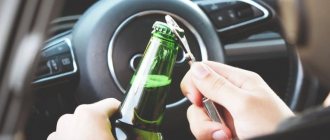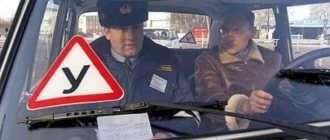What is considered dangerous driving?
The legislator described dangerous driving in paragraph 2.7 of the traffic rules. It includes six main violations.
Do not give way when changing lanes. The driver changes lanes into the adjacent lane and creates interference for those already driving in it - they are forced to brake sharply, and there is a threat of an accident.
Change from lane to lane. This is prohibited during heavy traffic, that is, in a traffic jam. When all lanes are occupied, you can only change lanes to turn, make a U-turn, stop, or avoid an obstacle, such as cars that have stopped due to an accident.
Don't keep your distance. The driver is too close to the car that is driving in front of him. By law, he is required to maintain a distance that will allow him to avoid crashing during sudden braking.
Drive between the rows. The lateral interval is often not observed by motorcyclists who ride between cars.
Brake sharply. Automobile drivers sometimes overtake a car, and then brake sharply in front of it. According to the rules, a driver can only brake like this if he is trying to prevent an accident.
Interfering with overtaking. A bad driver may not allow himself to be overtaken. To do this, he increases his speed when another car is ahead of him in the adjacent lane. If the road is two-lane and the other driver is driving in the opposite direction, this behavior can lead to a head-on collision.
These situations are considered dangerous driving if the driver commits more than two violations in a row and creates a risk of an accident.
What are typical violations?
Dangerous driving is divided into the following types:
- "checkers";
- "nervous";
- "hurry";
- "beds";
- "teacher";
- "stubborn".
Toropygi
This is a type of driving where the driver does not maintain a safe distance from the vehicle in front.
According to traffic rules, a safe distance is considered to be such a distance that allows the driver of a vehicle to avoid an accident.
You should also carefully monitor the safe lateral spacing between cars.
Stubborn
A type of driving in which the driver accelerates and prevents the vehicle behind from overtaking.
In this situation, the fault may lie with both parties to the accident.
The driver who is overtaking must make sure that by doing so he will not interfere with other road users. The person being overtaken should not increase his speed when he sees that he is about to be overtaken.
Teacher (educator)
This is a type of driving where a person deliberately brakes in front of a vehicle behind them.
Experts note that it is almost impossible to prove the driver’s guilt in this situation: whether he braked intentionally or tried to avoid the accident.
Checkers
This is a type of driving when a person unreasonably changes lanes from one lane to another when the lanes are fully loaded and thereby creates an emergency situation for other road users.
In this case, the driver does not move far forward, but moves at the average speed of the general flow and creates emergency situations along the way.
Beds (driving between rows)
A type of driving when driving along a line that separates traffic lanes, and the motorist does not observe the lateral interval between moving vehicles.
Motorcyclists are more likely to ride this way.
Most often, they are the ones who create emergency situations, since it is very difficult for the car driver to follow their movements.
Drift
This is a type of driving where a person steers a vehicle into a controlled drift.
Nervous
This is driving when the driver gets in the way of a vehicle that is trying to overtake him.
According to traffic rules, each driver is obliged to give way to vehicles that are moving in the same flow as him, without reducing the speed of the general flow.
A special website has appeared on the Internet: dangerous driving.rf, where you can get all the necessary information on the issue.
What is the responsibility for leaving the scene of an accident? Is there a tax deduction when donating a car? See here.
What are the criteria for dangerous driving?
Each of these violations by itself does not mean dangerous driving. To classify aggressive driver behavior, two additional conditions were introduced.
More than two violations in a row. The driver must break the rule several times one after another. The frequency with which violations must occur is not specified in the law. According to legislators, this creates a danger for other road users: they cannot predict the driver’s behavior and react adequately to avoid an accident.
Threat of an accident. Another prerequisite for dangerous driving is that the driver creates a situation in which other road users are forced to change direction and speed, otherwise they risk getting into an accident.
Dangerous driving: fight against drivers or another traffic police feeder?
The government decided to speak to drivers in a language they could understand and created videos to explain the term “dangerous driving.” But the latest move to advance the new rule raises more questions than answers.
The first time people started talking about punishing drivers for dangerous or aggressive driving at a high level was in 2012. Then deputies from the LDPR introduced a bill into the Duma, according to which for dangerous maneuvering, dangerous lane changes, sudden braking, dangerous approach to a car in front and then driving in close proximity to it, the driver could receive a fine of 2.5 thousand to 5 thousand rubles. But since there is no such concept in the traffic rules, the initiative did not pass. But the idea remained.
Its implementation began with the introduction of a definition in the Traffic Rules, approved just yesterday by government decree. When approving the document, Medvedev did not rule out the possibility that the wording would change and expand, but now the new clause of SDA 2.7 reads like this:
“ Dangerous driving is the repeated commission of one or the commission of several subsequent actions related to violation of the Rules, expressed in
— failure to comply with the requirement to give way to a vehicle enjoying the right of way when changing lanes;
- changing lanes during heavy traffic, when all lanes are occupied, except when turning left or right, making a U-turn, stopping or avoiding an obstacle;
— failure to maintain a safe distance from the vehicle moving ahead;
— non-compliance with the lateral interval;
— unreasonable sharp braking;
- preventing overtaking,
if these actions resulted in the driver creating a situation during road traffic in which his movement and (or) the movement of other road users in the same direction and at the same speed creates a threat of death or injury to people, damage to vehicles, structures, cargo or damage other material damage."
To better understand what the government means, videos have been created to explain each individual step of the definition. Well, so that both ordinary drivers and traffic police officers do not get confused and clearly understand what cannot be violated and what will need to be punished, the videos were given “folk” names: “Checkers” , “Nervyaki” , Toropygi” , “Beds” , "Educators" and "Stubborn" . I remember the expression: “Everyone thinks to the extent of his depravity.” What is going on in the minds of people who approve of such an illiterate presentation, both in essence (there is even an error in the decoding of “educators”) and in meaning?
Multiple lane changes
A bright red car with an exaggeratedly sporty appearance without the use of turn signals changes lanes several times in the 3D model, and four real-life videos demonstrate “changes of lanes in heavy traffic, when all lanes are occupied, except when turning left or right, U-turn, stopping or avoiding an obstacle." Everyone knows what a “game of checkers” is, and this cartoon and recordings from cameras and video recorders do not reveal this description. After all, the traffic rules do not define “heavy traffic”: what does it depend on - the number of cars, their speed, the intervals between them, or everything together. It is also unclear what “all lanes are occupied” means - is there a vehicle in sight or the interval between cars is less than their length? After all, in the examples the car is being rebuilt, therefore, there is free space for this. And from the entire description of the “checkers” it follows that, having entered the road, the driver does not have the right to change lanes unnecessarily, and changing lanes to avoid potholes and potholes on the road can already be considered a violation - after all, they are not an obstacle. However, the rule according to which on highways you need to stay in the right lane, and in populated areas “it is allowed to change lanes only to turn left or right, make a U-turn, stop or go around an obstacle” is already contained in the current traffic rules under clause 9.4, and punishment for abrupt changes stripes are possible in accordance with clause 3 of Art. 12.14 of the Administrative Code (fine 500 rubles), and if turn signals were not used yet, then clause 1 of the same article and another 500 rubles are added.
Trimming when changing lanes
The scheme is the same - a cartoon and four real stories that show “failure to comply with the requirement to give way to a vehicle enjoying the right of way when changing lanes.” It’s a pity that in terms of meaning, only one of them is more or less suitable, and even then with a stretch: the crossover in front of a traffic light is converted into a GAZelle, but it does this in order to let an ambulance with its beacon on pass. The first example from life is incorrect - a taxi changed lanes slowly, turning on the turn signal, and if such a lane change is considered a violation, then drivers will wait for hours for a suitable window in traffic. In the other two, drivers were clearly distracted from the road and, returning to reality, performed incorrect, but at the same time single actions - changing lanes and braking. In the simulation, the multiplicity is observed - the red BMW, which is represented by the same “Nervyak”, changes lanes twice “unexpectedly” and for some reason slows down in the traffic, but at the same time it gets lost and then the “source” of its problem arises again - a leisurely white car in left lane, also violating traffic rules.
Failure to maintain a safe distance
Maintaining a distance between cars is a requirement enshrined in paragraph 9.10 of the Rules. But both the existing and proposed norms do not stipulate this distance. Each driver must solve this problem for himself, taking into account his reaction, the capabilities of the car, the quality of the tires and road surface, and weather conditions. But the video focuses not so much on the fact that the car is driving too close to the one in front, but on the fact that the “hurry” forces the car to clear the lane by flashing its headlights. But for such unlawful use of high beams there is no punishment and is not provided for, although the traffic rules indicate that “to warn about overtaking... a light signal may be given, which is a short-term switching of the headlights from low beam to high beam” (clause 19.11).
Failure to comply with lateral spacing
As with the previous example, neither the current nor the proposed rules stipulate a safe interval between vehicles. Moreover, this very interval depends on both the vehicle and the road markings. Although the violation is really more typical of motorcyclists, whose ranks are growing every year, precisely because they can at least somehow ride between the rows, and not stand in a traffic jam. But this is also common in cars. Remember the situations when, when the road narrows, cars are squeezed out of their lanes, but do not yet have time to occupy the adjacent lane. Judging by the description, this is also a violation.
Sharp braking
This is perhaps the only video and indication in the definition that can find support. After all, situations on the road develop differently, and such offended “educators” or “teachers” really create emergency situations. But again, such a rule is already in the traffic rules: clause 10.5 “The driver is prohibited from sharply braking if this is not required to prevent a traffic accident.” And if the rule was not universally followed that the one behind is at fault - due to failure to maintain a distance - then this class of drivers, after a couple of uncollected insurance payments, would have been transferred by itself.
Impeding overtaking
Like most violations, this norm is already prescribed in the traffic rules (clause 11.3). And such a meager formulation is explained by the fact that it is impossible to reflect all the nuances of such a maneuver. All the videos are evidence of this: in the first there is an obvious misunderstanding, in the second the person simply avoids potholes on the roads, and in the last, and most terrible, scene, the white “six” prevents overtaking in a closed corner. And the model clearly shows emergency situations - there is not enough free distance to traffic in the oncoming lane to overtake.
Both the wording of the new rule and the computer graphics emphasize the multiplicity of actions performed. However, the number with which it begins is again not given. How many times you need to drive between lanes or change lanes, creating an obstacle - 2, 3 or 10, how many lane changes create a multiplicity is not clear. Therefore, if it is possible to hold people accountable only on the basis of a video filmed by law enforcement agencies or the drivers themselves (this is the evidence base that is considered admissible), then there will be few such videos - the likelihood of filming the same “educator” or “hurry-up” is extremely low. If a traffic police officer decides how dangerously a person drives a car, then almost any driver can be held accountable for the slightest deviation. However, fines for failure to use turn signals, failure to maintain lanes and other violations cost 500 rubles. It’s possible now, but no one is doing it.
Natalia Agre, president of the expert:
“The most important thing is that the term “dangerous driving” is being discussed at the official level and will be introduced. It seems to me that it will be quite secondary how these violations will be examined and what the size of the fine will be. The main thing is to form the attitude of road users towards this type of violator. The same as was done in relation to drunk drivers. About 10 years ago, drinking and driving was considered good manners, a manifestation of courage and driving skills. Now this is unacceptable and antisocial. The same should happen with dangerous driving. The appearance of this site and those attempts at decryption should explain what it is and how dangerous it is. This needs to be refined, deciphered and deepened, but the work is going in the right direction.”
But even if you write down all the numbers for intervals, speed, number of cars per square meter, how can the driver comply with this and prove it to the inspector? By eye? We still do not have regulations for checking the wear of tires, which can be tested statically with a special device that has been verified. But here you need to prove the movements in centimeters of moving objects - unrealistic. And no “three seconds” formula, which is recommended to be used to calculate the distance, will help.
Vyacheslav Lysakov, first deputy chairman of the State Duma Committee on State Construction:
“These examples of dangerous driving are needed to understand what type of offense they relate to. It is clear that these are not separate violations, or two in a row, but a chain of violations lasting over time. The main thing here is not only the wording, which is described in sufficient detail in the draft changes, but how dangerous driving will be recorded. Of course, it should be recorded not by eye, but on video media. For this purpose, an application developed by the Ministry of Internal Affairs and the Ministry of Communications will be launched, which allows users to download video from DVRs and smartphones. It will be 100% evidence-based, since it will be protected, among other things, by the individual signature of the sender. It turns out that now drivers are getting acquainted with the norm, then it will be included in the traffic rules, then internal orders and regulations will appear that determine the practice of application, and in the fall a corresponding amendment will be made to the Code of Administrative Offenses.”
And a question to the final phrase of the definition of dangerous driving: “if these actions ... create a threat of death or injury to people, damage to vehicles, structures, cargo or other material damage.” Any vehicle is dangerous (Article 1079 of the Civil Code), therefore any movement on it can be interpreted as a threat, and all additional descriptions with a passing direction, etc. are just words that will be interpreted in the direction someone needs.
First Deputy Prime Minister Igor Shuvalov: “This library (meaning information on the website - editor's note) will be replenished, we will continue to consider it, and other additions to it. So far, the agreement with the Ministry of Internal Affairs is this: with their circulars and internal explanations they will direct traffic police officers to be guided by the examples that are in this library when determining whether a driver’s driving was dangerous or not. I’ll say again that at the moment there are six such examples, employees will not consider any others besides these for now - only after public discussions have taken place and additions to this library have taken place.”
But looking at official videos about dangerous driving, it becomes completely unclear what kind of driving culture we are talking about when the state itself at the federal level imposes on us “nervous” and “stubborn”? And instead of bringing the good and eternal in the form of thoughtful traffic management and quality roads, budget money is spent on concepts about “hurry” and “beds”. The stereotype is confirmed that expensive sports cars, mostly red, are driven aggressively, but in practice they violate ordinary Zhigulis and foreign cars that are not the first freshness. And no matter how many terms and fines are introduced, those who are already violating will continue to do so. After all, the new traffic rules do not abolish the administrative resources of such reckless drivers, nor the habit of “resolving the issue” for money. But it is precisely these drivers who can afford such behavior; for ordinary people it is too expensive.
The traffic police conducted a survey on its website, and 41% of the 17 thousand voters supported the emergence of the concept of “dangerous driving,” and another 30% supported its introduction, but subject to the presence of significant evidence of guilt. One can only rejoice at this result - there are more people who have no reason not to trust the inspector. And inspectors, in turn, are given complete carte blanche to hold drivers accountable. But for the sake of a good goal - to improve road safety, everything can be done, and the main thing is to adopt norms that duplicate existing rules, limit drivers, increase the corruption component, and lead to an increase in cases in the courts.
Petr Shkumatov, coordinator of the Blue Buckets movement:
“These videos are like a non-commissioned officer’s widow who flogged herself. They dispelled all doubts about whether the term “dangerous driving” should or should not be introduced. Of course not. Because even the authors of these amendments themselves do not understand what is dangerous driving and what is a common violation. In particular, cars are shown that change lanes in a permitted location. They wanted to show a reckless driver, but it turned out that they showed drivers in work situations. In this case, there is confusion in concepts. And if the rule-makers do not have an understanding of what dangerous traffic is, then for ordinary people completely different situations are dangerous: for some, oncoming traffic, for others, the side of the road, or something else. There is no agreement either in society, or among experts, or among the authors themselves, what is considered “dangerous” and what is not dangerous driving. Questions with an evidence base: how to prove something that is not stated in the law. This makes the formulation absolutely corrupt. They will punish you either for the purpose of profiting, or to account for the raid.”
Quotes from comments on the website “dangerous driving.rf”:
“Increase the speed limit in the far left lanes, and you won’t have to come up with new reasons for “vague” fines from the inspector. Stop blocking the center for 2 hours, buy helicopters (by the way, it will be much cheaper than escorting a motorcade), and there will be no nerves on the road. Do not drive powerful cars for people under 5 years of experience (category “U” license, power limit, overtaking ban, 80 km/h maximum speed). In driving schools, teach extreme driving not on paper, but in practice, making it clear to a young burning teenager that a car cannot “do everything”, but lives according to the laws of physics, without knowing which you simply cannot get behind the wheel. And most importantly, make roads without protruding hatches by 5 cm and “pothole repairs, which, by the way, do not exist in the world of road construction engineers in any of the civilized countries.” That’s it, roads like those in Moscow can definitely ensure flying into oncoming traffic or into a bump stop... It’s very good to come up with and highlight bullshit when global problems are not being solved.”
“Well, actually, thanks to such “competent” judgments, such bills take place, and the driving culture rests on ignoramuses who are not familiar with the kinematics of a car’s movement, nor with its physical properties, nor with the effectiveness of various speed modes in urban conditions on multi-lane roads . We will be afraid of increasing the speed limit of the extreme left lane, and introduce bills that will allow any of your maneuvers, if necessary, to be interpreted as a violation of the law. There is no corruption in the country, the inspector is an absolutely disinterested person!”
“I wonder where this criminal jargon on the official website came from? What is this: beds, nervous people, stubborn? What kind of bandits or street racers are developing this law? Absolutely everything that is described in these criminal terms is already prohibited by traffic rules. And not in a criminal way and not abstractly, but concretely and with a description of the situation. All authors of this site and this legislative initiative must be deprived of their driver's licenses. After all, these people don’t know the traffic rules; it’s unknown how they passed the exams.”
“The issue of forcing careful driving has been partially resolved. And as usual, we are fighting the investigation. Every action has a "cause and effect". You cannot fight the “investigation” with laws. The law must eradicate “causes.”
“Oh, come on... Who violates the most? Either those who have a lot of money and for him speeding fines are the same as paying for a bus fare for me, or those who have good connections.”
“In many countries of Europe and America, and especially in Asian countries, row spacing is not only allowed, but also enshrined in law. In France, this year (2016) large cities allowed row spacing, under very fair conditions. Among the motorcycle community, there have long been the same rules that say: “Ride only in the far left lane (between the car on the far left and the one to the right of it).”
“But it’s very interesting who and HOW will track this, because in order to see the full picture of what is happening, you often have to drive more than one kilometer behind the car to understand whether a person violated or was forced to perform this or that action!! Nonsense!".
“I’ll be a captain, but this is just another feeding trough for our valiant traffic safety inspectors. All these situations are already described in the rules. But they don’t want to fight offenders, apparently, which is why they are introducing duplicate bills as additional income to the valiant traffic police. Maybe you'll stop wasting your time and start punishing violators? And... here’s something else I liked about the news... A portal will be created through which you can “snitch” on the driver by downloading the video from your dashcam. Cool, isn’t it?) We sign the law, informers complain, this is how the citizens themselves suppress violations, and the traffic police simply skim off the cream in the form of fines and send you “chain letters”) It seems to me that it would be impossible to come up with a better idea!).”
“Perhaps the problem is not that we lack something in the law, but, as always, that there is a lack of law enforcement practice? Maybe we need to motivate the traffic police to work more efficiently? Since drivers are required to fill out documents on the spot without calling traffic police officers, it is assumed that they have more time to perform their main function - ensuring traffic safety. However, I personally do not observe an increase in traffic police officers on the road, i.e. where they belong. Where did they all go? Where do they provide security, in their offices?”
PS Government Resolution No. 477 was signed by the Chairman of the Government on May 30 and has already entered into force. So far, nothing has changed for drivers - even if their actions can be interpreted as “dangerous driving,” they can only be punished under the current articles of the Administrative Code. The situation will change when the corresponding norm appears in the Code, and this will not happen earlier than in the fall. And judging by the activity of the government, this will be one of the first laws adopted by the Duma of the new convocation. The punishment will be a fine of 5,000 rubles and, possibly, stricter prosecution.
What is the fine and for what?
Since 2021, the traffic police has been seeking to have a new article 12.38 on dangerous driving introduced into the Code of Administrative Offences. In this case, a fine of 5,000 rubles will be imposed for aggressive behavior on the road. The bill on the new fine passed the first reading in the State Duma, but has not yet been adopted.
Daria Ponomareva, forensic expert-autotechnician "Auto MFC" Before the bill is adopted, it must go through a global approval procedure in different authorities and departments. Meetings on the bill were repeatedly postponed because expert opinion on the issue was needed.
The Administrative Code already contains penalties for certain violations:
- change lanes and do not give way to a car in this lane - 500 rubles under Part 3 of Art. 12.14 Code of Administrative Offences;
- violate the rules for positioning a car on the road: change lanes in a traffic jam, do not maintain distance and lateral intervals between cars, brake sharply, prevent overtaking - 1,500 rubles under Part 1 of Art. 12.15 Code of Administrative Offences.
By law, these fines can be paid with a 50% discount if you manage to do this in the first 20 days.
What are the fines for dangerous driving in the Russian Federation in 2021?
Fine for speeding in 2018
The bill, approved by the relevant government commission, is planned to simply supplement the Code of Administrative Offenses of the Russian Federation. The purpose of the law is to oblige drivers to adhere to traffic rules and not create emergency situations on the road. Or perhaps this is just an item to replenish the budget, since some concepts about dangerous traffic duplicate already existing traffic standards.
The bill is based on a sociological survey in which more than 20,000 people participated. The survey found that 38% of respondents strongly supported the law due to the increase in aggressive driving. 29% supported the initiative in general if clear evidence of the driver’s guilt was received.
How the traffic police proves dangerous driving
Under the presumption of innocence, the driver is not required to prove that he has violated anything. This must be done by traffic police officers. The exception is when the violation was caught on a video camera. Cases of dangerous driving cannot be photographed, so the traffic police proves them in the usual way.
Protocol. The inspector stops the violator and draws up a protocol to record the violation. A copy remains in the hands of the driver.
Resolution. Later, the traffic police, together with the driver or in his absence, conducts an analysis. Based on the results, the traffic police sends the driver a decision on an administrative violation. It arrives by mail, but not always - it’s better to check your fines.
How to dispute. If the driver does not agree with the decision, he can file a complaint addressed to the head of the traffic police department that issued the fine. The application can be sent through the traffic police website, on the application acceptance page. There are 10 days for this from the date of the decision. Another option is to file a complaint in court.
Near and far abroad
Traffic regulations in many countries have improved the definition of “aggressive driving”. In the list of violations specified in this amendment about dangerous driving, other countries also included:
- driving at a red traffic light;
- ignoring markup;
- driving on the side of the road;
- overtaking another driver on the right;
- pruning;
- using high beams during the day;
- neglect of pedestrians;
- insulting anyone
- aggressive gestures;
- illegal use of a sound signal.
The penalties for such violations are more severe. Their experience includes not only monetary penalties, but loss of rights up to and including imprisonment. Below is a list of countries that have the most severe penalties.
- in Australia – the fine can reach $5,500, as well as deprivation of a driver’s license for up to five years;
- Japan, in turn, also received a fine, plus disciplinary work;
- Germany - punishes with money in the amount of 250 euros and deprives of a driver's license for approximately 3 months;
- in the USA - a fine ranging from 500 to 2500 dollars, and up to 6 months in prison;
- In England, penalties are imposed in the form of a fine. Also imprisoned for up to 5 years.
- Dangerous driving: how to identify the culprit?
The movement of vehicles is recorded on video cameras located on highway overpasses, in inspectors' cars, as well as video recorders of ordinary traffic participants. But these funds are not enough to bring all violators to justice. This is what the leadership of the country's traffic inspectorate itself is talking about today. They admit that not even all available street cameras can record aggressive driving violations.
Of course, no camera can record driver aggression. The traffic police are also not equipped to identify such violators. It remains to rely on the subjective opinion of the inspector himself.
So, the law that holds aggressive drivers accountable needs improvement. Loyal punishment and technical inability cannot protect us from road rage.
If you find an error, please select a piece of text and press Ctrl+Enter.
Didn't find the answer to your question? Find out how to solve exactly your problem - fill out the form below or call right now: +7 (499) 653-60-72 (ext. 692) (Moscow)+7 (ext. 610) (St. Petersburg)+8 (ext. 926) (Russia) It's fast and free!
Remember
- Dangerous driving under the law is when a driver violates the rules of maneuvering and changing lanes more than two times in a row, thereby creating a risk of an accident.
- There is no fine for dangerous driving, but there is a fine for improper lane changing and maneuvering, from 500 to 1,500 rubles.
- These fines can be paid with a 50% discount in the first 20 days.
- Such violations are not recorded by cameras. The inspector must stop the violator, draw up a report, and later the traffic police will send a resolution.
- If you do not agree with the violation, you can appeal it - to the traffic police or through the court.
All articles by the author: Ilya Novikov
How to get a fine
In order to receive a fine for dangerous driving, you must perform several dangerous maneuvers in front of a traffic police inspector. The officer who stopped the car will draw up a protocol, which will include all the details of the offense, and send it to the head of the traffic police, handing the driver a copy with the date and time of the meeting at which his case will be considered.
If the driver appears at the meeting, he will be able to take part in it and present arguments in his defense. Otherwise, a copy of the decision will be sent to him.
What doesn't count?
But not all driver actions that at first glance seem dangerous can be equated to dangerous driving.
In what cases will driving not be equated to such:
- failure to maintain a distance from the vehicle in front. Example – cars are standing close to each other in a traffic jam;
- drifting;
- changing lanes from row to row, carried out without turning on;
- turn from the second row.
In other words, if the action is not specified in the points of dangerous driving, then it cannot be equated to it. The rule works: what is not prohibited is permitted.
What it is
For the first time, dangerous driving was introduced as an official concept back in the summer of 2016. Then the traffic rules introduced such a concept or definition as dangerous driving.
According to the legislative act, the term implies repeated performance by the same person of actions that can provoke and entail risks of injury, injury and death to people, as well as causing material damage to individuals, organizations and government property.
In this case, the situation will be much more serious if such dangerous actions or acts in the form of offenses are committed by the driver sequentially one after another. Roughly speaking, we are talking about several traffic violations that are included in one general episode. The driver could exceed the speed limit, fly into the oncoming lane or sidewalk, hit people or damage other vehicles, fly into a building, etc.
The considered definition is general for such a term. But the law provides for specific offenses that may fall under the concept of dangerous driving or reckless driving. They are discussed separately in the relevant articles of the traffic rules. That is, the new term acts as a unifying concept for a number of regulations and provisions.
Under what conditions is driving extreme?
The first condition is that the driver commits two or more violations, one after the other. At the same time, traffic rules classify driving as dangerous if different points of the Rules are violated or when the same violation occurs multiple times. But since the concept of “one after another” is not specified, the classification of violations as dangerous is at the discretion of the traffic police officers. Practice shows that driving can be considered dangerous even in situations where the intervals between two violations are significant.
The second condition is the presence of a threat to the health/life of a person/people and/or the safety of someone’s property. It should be noted that it sounds unambiguous only in the case when it is possible to record that a danger has occurred. The fact of the realization of such a threat is definitely recorded during an accident, but if a collision of a car with other vehicles or other objects does not occur, then it is often very difficult to establish it.
A special case is drunk driving. The fact of recording the alcohol intoxication of a driver of a vehicle engaged in extreme driving may provide not only administrative liability (fine), but also criminal liability. The choice of one or another punishment for the driver for such a violation depends on the specific circumstances. These may be:
- driver's refusal to undergo an alcohol intoxication test. This situation is aggravated if it turns out that he does not have a driver's license;
- transfer by the driver of control of the vehicle to a person who is intoxicated;
- death of a person due to the actions of a driver who is intoxicated, etc.
Other special cases of violations are drug intoxication while driving and repeated registration of driving under the influence of alcohol or drugs. The driver is subject to administrative and criminal penalties for such violations. Administrative measures for violation - fine, arrest, deprivation of the right to drive a vehicle; criminal punishment - forced labor, imprisonment.
What criteria should be used to assess dangerous driving?
There are still many inaccuracies and controversial issues regarding dangerous driving.
And here are some unresolved questions:
- Dangerous driving is considered to be one that involves several maneuvers within a short period of time. What period of time is considered short? This could be a minute, an hour, a week, etc. Not a single regulatory document provides an answer to this question.
- which is considered to be heavy traffic on the highway. How many cars are there on the road? The question is open. There is still no answer to it. One should not forget that changing lanes from row to row can also be explained by the need to make a turn. This is no longer a violation at all.
- Everyone has heard about a safe distance, but no one knows how much it is in centimeters, meters. How should the driver understand at what distance he should drive from the vehicle in front.
But the most controversial issue remains the question of risks. What is considered an accident hazard and what is not? The issue is also not resolved. Everything remains at the discretion of the inspector. Everything is clear with the camera.
The disadvantage of this area is that in each individual case the decision is made by the inspector drawing up the protocol and the chief examining the case. That's all. Such norms are approved in the Code of Administrative Offences. And the fact that there may be a purely subjective human factor does not bother anyone.








